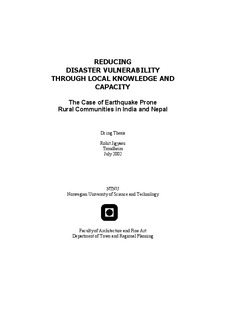| dc.description.abstract | This dissertation investigates the past and present status of local knowledge, skills and capacity of rural communities in India and Nepal for reducing their vulnerability to earthquakes. Disaster vulnerability is investigated not only as pre disaster condition but also as a continuous process, which is influenced by underdevelopment, process and various response decisions in post disaster situation. To get an integrated and dynamic picture of how local knowledge and capacity and disaster vulnerability influence each other, three case studies are investigated, namely Marathwada region in India, Kutch and Saurashtra regions in Gujarat in India and Kathmandu valley in Nepal. While the first case looks into the impact of post earthquake rehabilitation after seven-eight years, the second case looks in detail into the immediate transition phase from relief to rehabilitation, in a span of one year after the quake. To get an overview of total situation in both the cases, post disaster situation is essentially linked to the pre-disaster vulnerability situation. The third case looks into various transformation processes in rural communities, which create conditions for predisaster vulnerability. The three case studies are analysed for various underlying structural and non-structural causes that create negative conditions in which disaster vulnerability of these communities is increasing because of weakening local knowledge and capacity.
These case studies throw significant light on three inter-related aspects. First, they show key features of local knowledge and capacity of rural communities for mitigation, preparedness and recovery from earthquakes. They are embodied in physical planning and buildings, skills for using local resources, mutual support systems and informal livelihood mechanisms. Second, these (especially the Kathmandu case) provide an in-depth understanding of various transformation processes (pertaining to changes in built form, land use and ownership, occupational structure and social and economic structure) and their impact on traditional knowledge and capacity and resulting pre-disaster vulnerability to earthquakes. Third, these (especially Marathwada and Gujarat cases) show the implications of post earthquake rehabilitation on disaster vulnerability in the long run. These show, how certain decisions taken as part of rehabilitation not only reinforce pre-disaster vulnerabilities but also create new ones.
Five main issues and challenges in the context of rural communities of India and Nepal are pointed at for reducing their disaster vulnerability through building local knowledge and capacities. These are loss of material and land resources, loss of traditional skills, cultural incompatibility of external interventions, increasing social and economic inequity and weakening of local governance. The issue of culturally insensitive "transfer" of local knowledge is also taken up here. The research concludes by articulating socio-cultural, territorial and eco-developmental perspectives that can contribute towards developing a new framework (paradigm) for disaster management in India and Nepal.
Finally, I suggest strategies for introducing disaster management into strategies for rural development by regenerating rural livelihoods, formulating strategies for rural land management, improving spatial planning and building, improving quality of education on disaster mitigation and preparedness and most importantly finding out ways of intervening in local power structure. Several measures for improving post earthquake rehabilitation are also suggested. | nb_NO |
